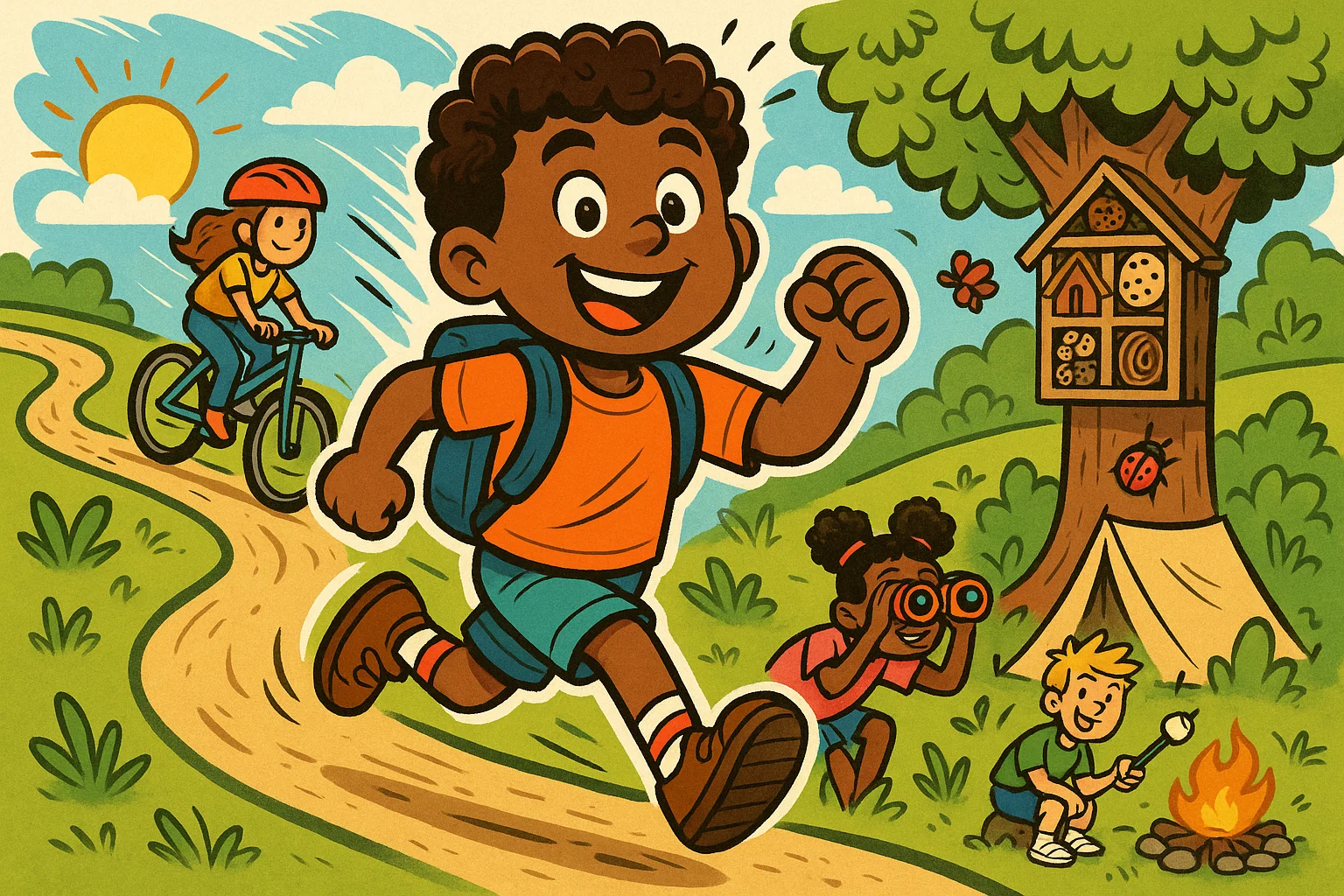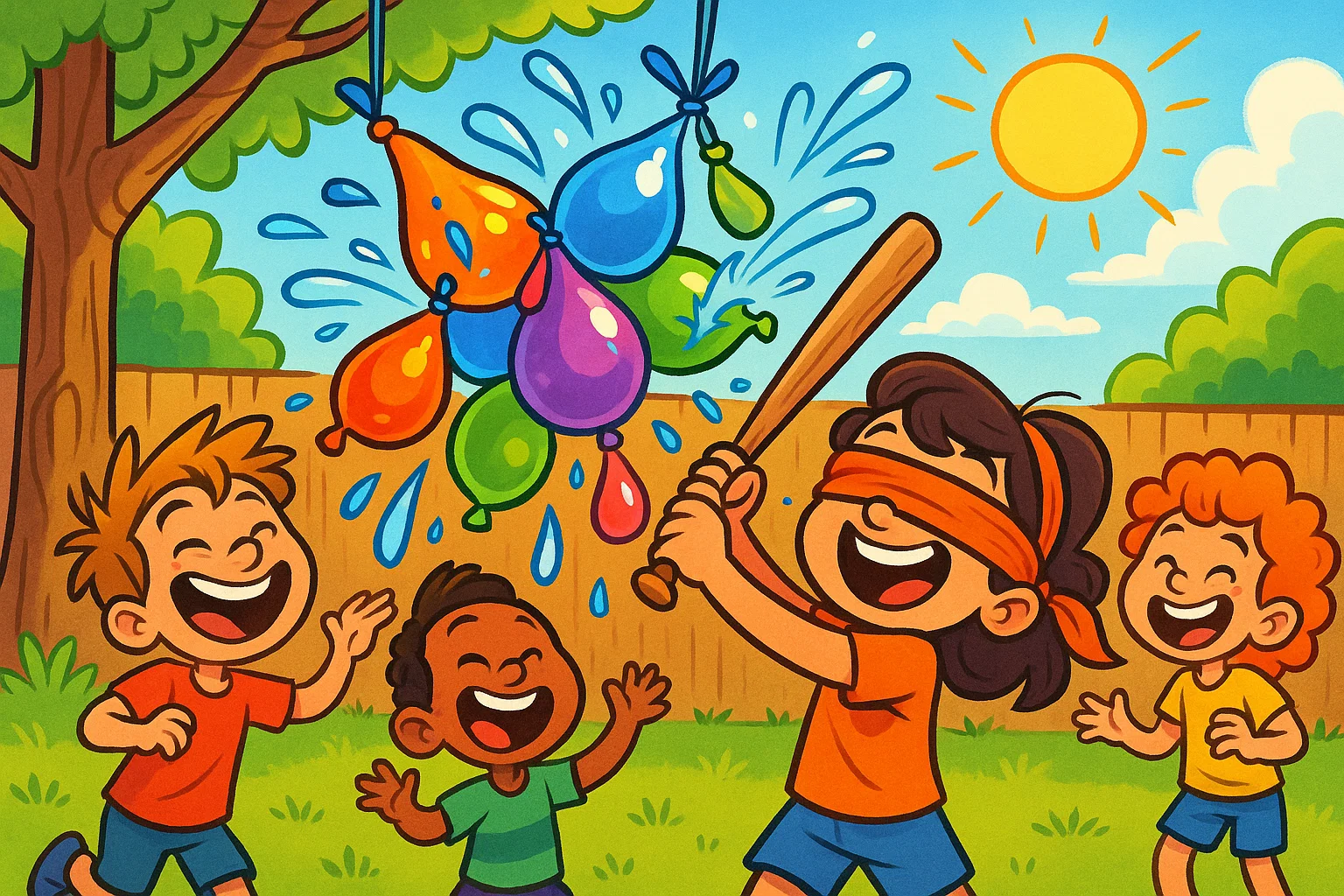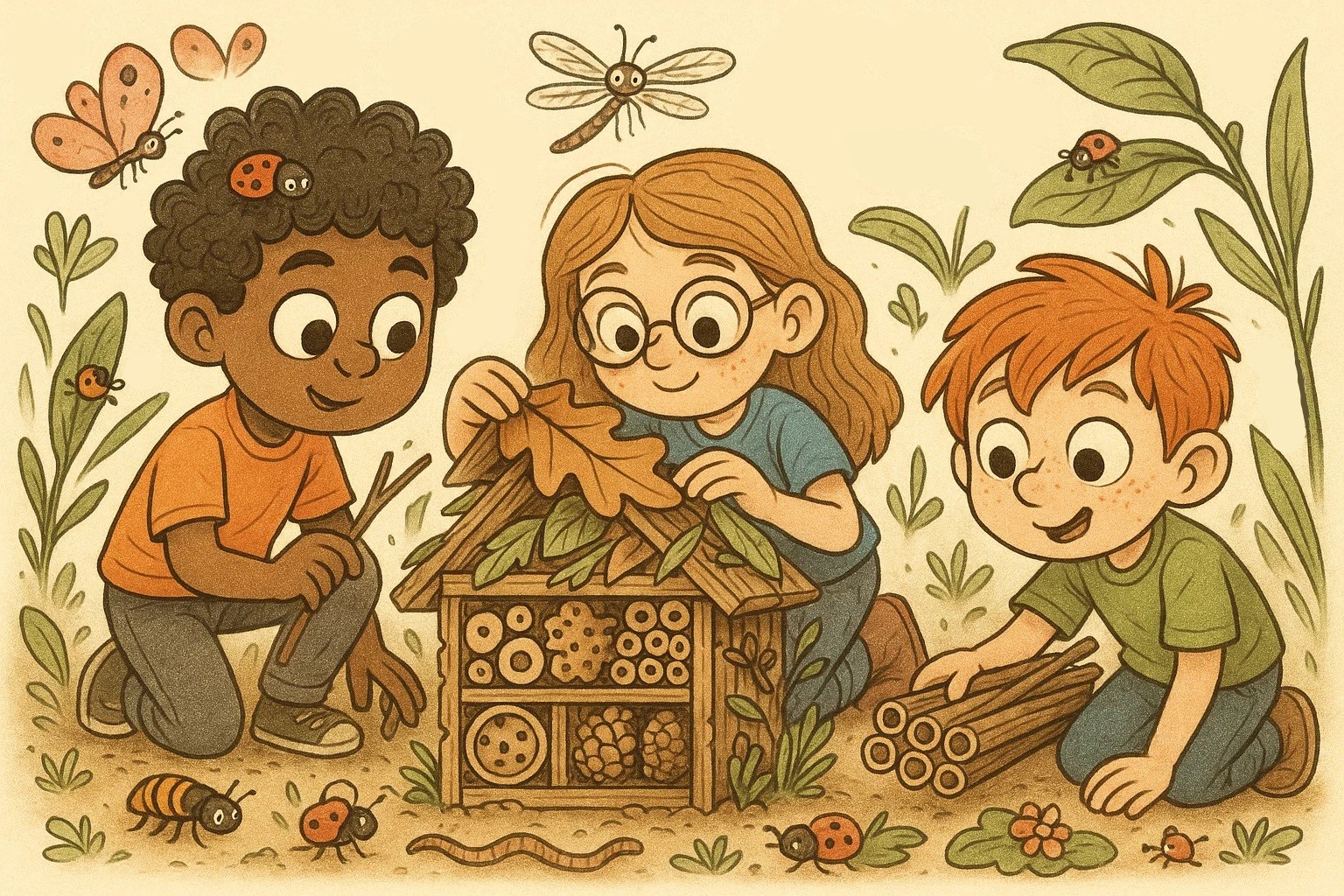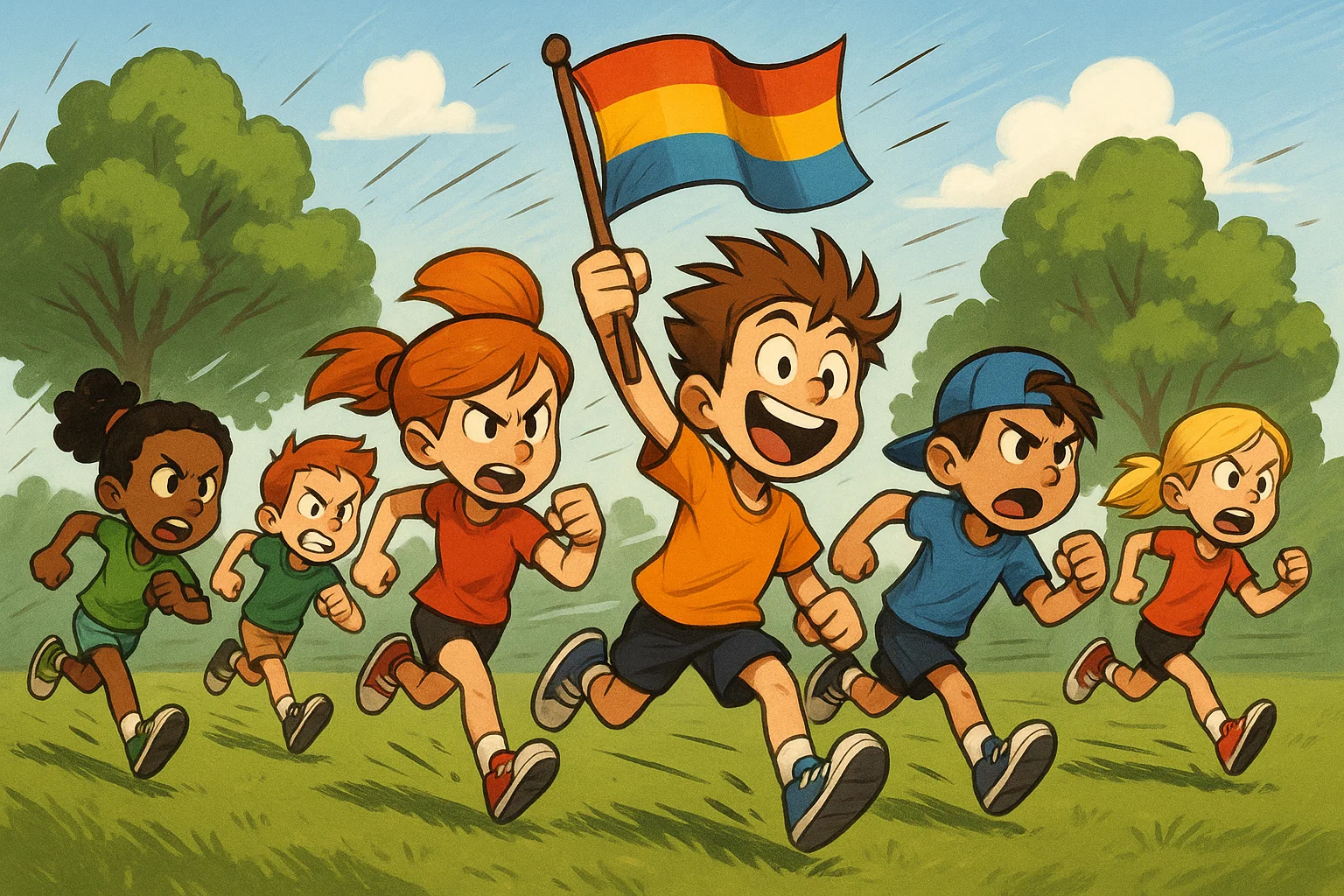Outdoor Activities for Kids

Getting kids away from screens and into the fresh air doesn’t have to be a battle. With the right mix of creativity, planning, and enthusiasm, you can transform any outdoor space into an adventure playground that captures children’s imagination while promoting physical fitness and social skills. Whether you’re working with a sprawling backyard or a simple park visit, these activities are designed to engage kids of all ages while fostering healthy development.
Fun Outdoor Activities for Kids 🎯

The key to successful outdoor play lies in variety and adaptability. These activities can be modified for different age groups, skill levels, and available space, ensuring every child can participate and enjoy the experience.
Water Balloon Piñata
Transform the classic piñata game into a refreshing summer activity by hanging water balloons from tree branches or playground equipment. Kids take turns trying to burst the balloons with a stick while blindfolded, creating an exciting challenge that combines coordination skills with cooling relief on hot days.
What you’ll need:
- Water balloons (biodegradable preferred)
- String or rope
- Wooden stick or bat
- Blindfold
- Towels for cleanup
This activity promotes hand-eye coordination while encouraging patience and turn-taking among players. For safety, supervise younger children closely and ensure the play area is clear of obstacles. Consider using biodegradable balloons and cleaning up all balloon pieces immediately after the game to prevent environmental impact.
Backyard Bowling
Create an instant bowling alley using empty plastic bottles as pins and any medium-sized ball. This simple setup provides hours of entertainment while developing motor skills and mathematical thinking as kids count pins and calculate scores.
To enhance the challenge, try filling bottles with different amounts of water or sand to vary their stability. Older kids and teens can create elaborate courses with multiple pin arrangements, while younger children might enjoy simply knocking down a few bottles. The beauty of backyard bowling lies in its adaptability – you can play it virtually anywhere with minimal equipment.
Scavenger Hunt
Design age-appropriate treasure hunts that encourage exploration and observation skills. For younger kids, create picture-based clues featuring items like “something red” or “a smooth rock.” Teens and tweens can handle more complex riddles and multi-step challenges that require problem-solving skills.
Scavenger hunt ideas by season:
- Spring: First flower buds, bird nests, baby leaves
- Summer: Colorful insects, smooth stones, different tree bark textures
- Fall: Various colored leaves, acorns, pine cones
- Winter: Animal tracks, icicles, evergreen branches
Research made by Sharmeen A Islam suggests that scavenger hunts significantly improve children’s attention to detail and environmental awareness. Consider seasonal themes to maintain year-round engagement and educational value.
Capture the Flag
This classic team game develops strategic thinking, communication, and cardiovascular fitness. Divide players into two teams, each defending their territory while attempting to capture the opposing team’s flag. The activity naturally promotes cooperation and leadership skills as players must coordinate their efforts.
For safety, establish clear boundaries and rules about physical contact. Younger children may benefit from simplified versions with shorter playing times and smaller territories. The game works well with groups of six or more players, making it ideal for birthday parties or family gatherings.
Bike Ride
Cycling offers excellent cardiovascular exercise while building confidence and independence. Start with familiar neighborhood routes, gradually expanding to bike paths and parks as children’s skills develop. Always prioritize safety with proper helmets and visibility gear.
For families with varying skill levels, consider destinations that offer multiple activity options – parks with playgrounds allow non-cycling siblings to participate while providing rest stops for longer rides. Research posted in Journal of Health and Rehabilitation Research indicates that children who regularly cycle show improved balance, coordination, and spatial awareness compared to their sedentary peers.
Disc Golf
This growing sport combines the precision of golf with the accessibility of frisbee throwing. Many communities now offer dedicated disc golf courses, but you can create a simple version using household items as targets in your backyard or local park.
The game promotes focus, patience, and mathematical skills as players calculate distances and angles. Unlike traditional golf, disc golf typically welcomes beginners and encourages experimentation with different throwing techniques. Most courses accommodate various skill levels, making it an excellent family activity.
Obstacle Course
Design challenging courses using everyday items like cones, ropes, hula hoops, and pool noodles. These courses can be adapted for any age group and provide excellent full-body exercise while developing problem-solving skills and spatial awareness.
| Age Group | Course Elements | Skills Developed |
| 3-5 years | Low hurdles, tunnels, balance beams | Basic motor skills, following directions |
| 6-10 years | Climbing walls, rope swings, target throwing | Coordination, strength, accuracy |
| 11+ years | Timed challenges, complex sequences | Strategic thinking, competitive spirit |
Easy obstacle course ideas:
- Crawl under a rope or pool noodle
- Hop through hula hoops laid on the ground
- Balance walk along a garden hose
- Toss bean bags into buckets
- Army crawl under a blanket stretched between chairs
- Jump over small cones or pillows
Encourage kids to time themselves and track improvements, fostering goal-setting behaviors and self-motivation. Consider seasonal modifications – winter snow obstacles or summer water elements – to maintain engagement throughout the year.
Educational Outdoor Activities 📚

Learning doesn’t stop when children step outside. These activities seamlessly blend education with outdoor fun, making complex concepts tangible and memorable through hands-on experience.
Bug Hotel
Construction of insect habitats teaches children about ecosystems, biodiversity, and environmental stewardship. Using natural materials like logs, bamboo tubes, and dried leaves, kids create shelters that attract beneficial insects to their gardens.
This long-term project demonstrates the interconnectedness of nature while encouraging patience and observation skills. Children often develop increased empathy for small creatures and better understanding of their role in the environment. Studies suggest that hands-on environmental education significantly improves children’s ecological awareness and conservation behaviors.
Visiting Historical Sites
Transform history lessons into adventure by exploring local historical sites, museums, and landmarks. These visits provide tangible connections to past events while encouraging curiosity about different time periods and cultures.
Tips for successful historical site visits:
- Research age-appropriate information beforehand
- Bring a camera for documentation
- Prepare questions to ask tour guides
- Create a post-visit discussion or journal entry
- Connect the visit to current events or family history
Prepare children with background information before visits, but allow for spontaneous discoveries and questions. Many historical sites offer youth programs or guided tours specifically designed for families. The experience of walking where historical events occurred often creates lasting memories that textbooks cannot match.
Nature Art
Encourage creativity using natural materials like leaves, stones, flowers, and twigs to create temporary art installations. This activity develops artistic skills while fostering appreciation for natural beauty and seasonal changes.
Land art projects teach children about impermanence and natural cycles as their creations weather and return to the earth. Photography can preserve these temporary masterpieces while building digital literacy skills. Some communities organize nature art festivals where families can display their outdoor creations.
Pizza Garden
Plant herbs and vegetables specifically for pizza making – tomatoes, basil, oregano, and bell peppers. This project teaches botany, nutrition, and patience while providing delicious rewards for the family table.
Essential pizza garden plants:
- Cherry tomatoes – easy to grow and perfect size for kids
- Basil – aromatic and fast-growing
- Oregano – perennial herb that returns each year
- Bell peppers – colorful and nutritious
- Garlic – plant in fall for summer harvest
- Onions – green onions grow quickly from kitchen scraps
Children learn the connection between soil health and food quality, often becoming more adventurous eaters when they’ve grown their own ingredients. The garden provides opportunities for mathematical learning through measuring, spacing, and harvest calculations. Consider companion planting techniques to demonstrate natural pest management.
Birdwatching
Introduce children to local bird species through observation and identification activities. Start with common backyard birds, gradually expanding to different habitats and seasonal migrations.
This quiet activity develops patience, attention to detail, and scientific observation skills. Many children find the challenge of identifying different species highly engaging, leading to broader interests in biology and conservation. Field guides designed for children make the hobby accessible and educational.
Safety Tips for Outdoor Activities ⚠️

Prioritizing safety ensures that outdoor adventures remain positive experiences for everyone involved. Proper preparation and awareness significantly reduce risks while maintaining the spontaneous joy of outdoor play.
Dressing Appropriately
Layer clothing to accommodate changing weather conditions and activity levels. Closed-toe shoes provide essential protection for most outdoor activities, while weather-appropriate outerwear prevents discomfort and potential health issues.
Essential outdoor clothing checklist:
- Comfortable, weather-appropriate layers
- Closed-toe shoes with good grip
- Hat for sun protection
- Light jacket or sweatshirt for temperature changes
- Extra socks in case feet get wet
- Bright colors for visibility during group activities
Consider the specific demands of planned activities when selecting clothing. Avoid loose clothing near playground equipment or during bike rides to prevent entanglement hazards.
Sunscreen and Hats
Apply broad-spectrum sunscreen with at least SPF 30 fifteen minutes before outdoor exposure, reapplying every two hours or after water activities. Wide-brimmed hats provide additional protection for face, neck, and ears.
UV exposure accumulates throughout childhood, making early protection habits crucial for long-term skin health. Seek shade during peak sun hours (10 AM to 4 PM) when possible, and encourage frequent water breaks to prevent overheating.
Outdoor Awareness
Teach children to recognize potential hazards like uneven terrain, poisonous plants, and changing weather conditions. Age-appropriate discussions about stranger safety and boundaries help kids navigate public spaces confidently.
Establish clear boundaries for exploration and designate meeting points for group activities. Children should understand basic emergency procedures and know their contact information. Regular safety reminders help reinforce good habits without creating anxiety.
First Aid Kit
Maintain a well-stocked first aid kit appropriate for your planned activities and group size. Include basic supplies like bandages, antiseptic wipes, pain relievers, and emergency contact information.
Basic outdoor first aid kit contents:
- Adhesive bandages in various sizes
- Antiseptic wipes or spray
- Gauze pads and medical tape
- Instant cold pack
- Children’s pain reliever
- Insect sting relief
- Emergency contact information
- Any personal medications
Consider activity-specific additions like instant cold packs for sports injuries or insect sting relief for nature hikes. Ensure at least one adult in the group understands basic first aid procedures. Regular kit inventory prevents supply shortages during emergencies.
Popular Outdoor Games for Different Ages 🏃♂️

Age-appropriate game selection ensures maximum participation and enjoyment while accommodating different developmental stages and physical abilities.
Red Light, Green Light
This simple game builds listening skills and impulse control while providing moderate physical exercise. Players must freeze immediately when they hear “red light” and continue moving on “green light.”
The game naturally accommodates different age groups, as younger children focus on following directions while older kids might challenge themselves with specific movement patterns. Consider variations like “slow light” for controlled movement or themed versions featuring different animals or vehicles.
Kick the Can
A variation of hide-and-seek that adds strategic thinking and teamwork elements. One player guards a can while others hide, attempting to kick the can without being tagged. The game promotes problem-solving and cooperative play among mixed age groups.
Safety considerations include establishing clear boundaries and ensuring the playing area is free from hazards. The game works particularly well in areas with natural hiding spots like trees, playground equipment, or garden features.
Ultimate Frisbee
This team sport combines elements of football, soccer, and basketball while emphasizing fair play and self-officiating. Players advance a disc by passing to teammates, scoring points by catching it in the opposing team’s end zone.
The sport naturally promotes cardiovascular fitness, hand-eye coordination, and strategic thinking. Most communities have youth leagues or casual pickup games where beginners can learn from experienced players. The emphasis on sportsmanship makes it particularly valuable for character development.
Family-Friendly Games
Design inclusive activities that accommodate multiple generations and skill levels simultaneously. Examples include parachute games, relay races with modified challenges, or cooperative building projects using natural materials.
Multi-generational game ideas:
- Three-legged races with parent-child pairs
- Water balloon toss with increasing distances
- Nature relay collecting specific items
- Storytelling circles in outdoor settings
- Group juggling with soft balls or bean bags
- Human knot problem-solving games
These activities strengthen family bonds while ensuring no one feels excluded due to age or ability differences. Consider rotating leadership roles, allowing children to direct games and make rule modifications based on group needs.
Frequently Asked Questions
How can I encourage my screen-obsessed teenager to participate in outdoor activities?
Start with activities that incorporate their interests – photography walks for social media content, geocaching for tech-savvy adventure seekers, or outdoor fitness challenges that can be tracked and shared. Gradually introduce pure outdoor experiences as they develop confidence and enjoyment in natural settings.
What outdoor activities work well for large groups of kids with different ages?
Parachute games, nature scavenger hunts with varied difficulty levels, and relay races with modified challenges accommodate diverse age groups effectively. Consider station-based activities where kids rotate through different challenges appropriate to their developmental stage.
How do I maintain outdoor activity engagement during different seasons?
Embrace seasonal changes as opportunities for new experiences – snow fort building in winter, leaf pile jumping in autumn, flower pressing in spring, and water play in summer. Each season offers unique learning opportunities and sensory experiences that keep outdoor time fresh and exciting.
What safety precautions should I take for water-based outdoor activities?
Always supervise children around water, ensure proper swimming abilities match activity demands, and maintain appropriate safety equipment like life jackets when necessary. Establish clear boundaries for water play and teach children to ask permission before approaching any water source.
How can I create engaging outdoor activities with limited space or resources?
Focus on creativity over equipment – use household items for games, explore nearby public spaces like parks or trails, and emphasize activities that require minimal setup like walking games, nature observation, or simple physical challenges. Many of the most memorable outdoor experiences require nothing more than imagination and enthusiasm.
